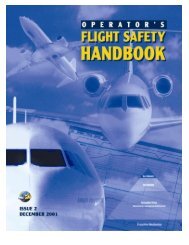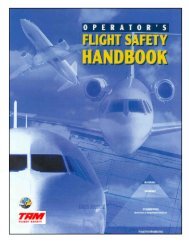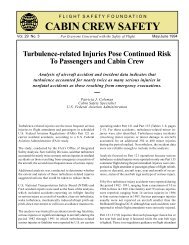Download PDF [10.9 MB] - Flight Safety Foundation
Download PDF [10.9 MB] - Flight Safety Foundation
Download PDF [10.9 MB] - Flight Safety Foundation
You also want an ePaper? Increase the reach of your titles
YUMPU automatically turns print PDFs into web optimized ePapers that Google loves.
ONRECORD<br />
airport. He attempted to extend the landing<br />
gear, but the down-and-locked annunciator light<br />
for the left main landing gear did not illuminate.<br />
“The pilot confirmed that he had an unsafe<br />
gear indication on the left main landing gear,”<br />
the NTSB report said. “He then actuated the test<br />
switch, and all three lamps illuminated, demonstrating<br />
that he did not have a burned-out<br />
indicating lamp.”<br />
The pilot cycled the gear, but the problem<br />
persisted. He said that while subsequently using<br />
the backup manual gear-extension system,<br />
“the pressure required to pump the gear down<br />
became greater and greater until something gave<br />
PISTON AIRPLANES<br />
Engine Fails on Takeoff<br />
Beech E18S. Destroyed. One fatality.<br />
Shortly after taking off from Runway 09L at<br />
Opa-Locka (Florida, U.S.) Executive Airport<br />
for a cargo flight to the Bahamas the morning<br />
of May 2, 2011, the pilot told ATC that he<br />
was turning downwind, rather than departing to<br />
the east, as planned.<br />
“According to witnesses, the airplane did<br />
not sound like it was developing full power,”<br />
the NTSB report said. “The airplane climbed<br />
about 100 feet, banked to the left, began<br />
losing altitude and impacted a tree, a fence<br />
and two vehicles before coming to rest in a<br />
residential area.” The pilot, alone in the airplane,<br />
was killed, but no one on the ground<br />
was hurt.<br />
Investigators found that the pilot “had<br />
been having problems with the no. 2 [right]<br />
engine for months [but] continued to fly the<br />
airplane,” the report said, noting that the<br />
Twin Beech had been parked outside in a<br />
moist environment.<br />
Examination of the right engine revealed<br />
several discrepancies that would have caused<br />
“erratic and unreliable operation,” including internal<br />
corrosion preventing both magnetos and<br />
the fuel pump from functioning properly, and<br />
low compression in four of the nine cylinders.<br />
way,” and the annunciator for light the left main<br />
gear did not illuminate.<br />
“The pilot completed the landing on the<br />
nose and right main landing gear, which resulted<br />
in substantial damage to the left wing and<br />
fuselage,” the report said.<br />
Examination of the left main landing gear<br />
revealed that the supports for the actuator<br />
bearings lacked adequate lubrication and were<br />
worn. Investigators were unable to determine<br />
whether the actuator had not been lubricated<br />
properly during installation 31 months earlier<br />
or subsequent inspections did not detect a loss<br />
of lubrication.<br />
The report also said that the engine likely<br />
had lost power on takeoff and that “there was no<br />
evidence that the pilot attempted to perform the<br />
manufacturer’s published single-engine procedure,<br />
which would have allowed him to maintain<br />
altitude. Contrary to the procedure, the<br />
left and right throttle control levers were in the<br />
full-throttle position, the mixture control levers<br />
were in the full-rich position, neither propeller<br />
was feathered, and the landing gear was down.”<br />
Parking Brake Overlooked<br />
De Havilland DHC-2 Beaver. Substantial damage. No injuries.<br />
After landing the single-engine airplane at<br />
a base camp on the Tahiltna Glacier in<br />
Alaska, U.S., on May 22, 2012, the pilot<br />
raised the landing skis, placing the Beaver on its<br />
wheels, and set the parking brake to prevent the<br />
airplane from sliding.<br />
Later, while preparing to depart from the<br />
base camp, the pilot lowered the skis but forgot to<br />
release the parking brake, the NTSB report said.<br />
The parking brake was still set when the<br />
pilot conducted a wheel landing on a hard-surfaced<br />
runway in Talkeetna. The Beaver came<br />
to an abrupt stop and pitched nose-down; the<br />
horizontal stabilizer was substantially damaged<br />
when it fell back onto the runway. The pilot<br />
and four passengers were not hurt.<br />
58 | FLIGHT SAFETY FOUNDATION | AEROSAFETYWORLD | MAY 2013


![Download PDF [10.9 MB] - Flight Safety Foundation](https://img.yumpu.com/18550968/60/500x640/download-pdf-109-mb-flight-safety-foundation.jpg)

![Download this Issue [PDF 7 MB] - Flight Safety Foundation](https://img.yumpu.com/18859635/1/190x245/download-this-issue-pdf-7-mb-flight-safety-foundation.jpg?quality=85)

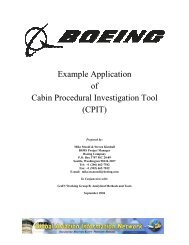

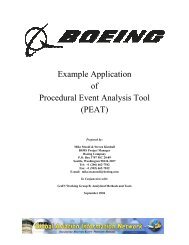

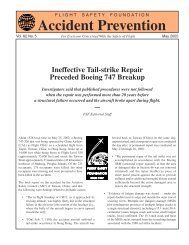
![Download [PDF 8 MB] - Flight Safety Foundation](https://img.yumpu.com/18859366/1/190x245/download-pdf-8-mb-flight-safety-foundation.jpg?quality=85)
